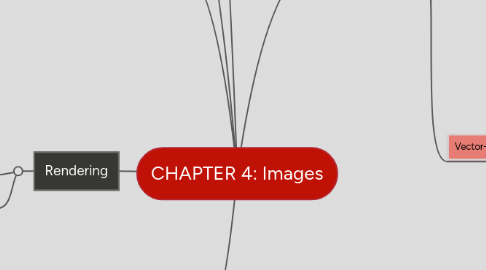
1. 3-D drawing
1.1. 3-D animation tools
1.1.1. Daz3D
1.1.2. Form*Z
1.1.3. NewTek's Lightwave
1.1.4. Autodesk's Maya
1.1.5. Trimble's SketchUp
1.2. Features of 3-D application
1.2.1. Modeling
1.2.1.1. Placing all the elements into 3-D space
1.2.2. Extrusion
1.2.2.1. Shape of a plan surface extends some distance
1.2.3. Lathering
1.2.3.1. Profile of the Shape is rotated around a defined axis
1.3. Panoramas
2. Rendering
2.1. Use of intricate algorithms to apply user-specified effects
2.2. Takes many hours for a single image
3. Understanding Natural Light and Color
3.1. Additive color
3.1.1. Color is created by combining colored light sources in three primary color - red, green and blue (RGB), Example: TV and computer monitors
3.2. Subtractive color
3.2.1. Color created by combining colored media such as paints or ink.
3.2.2. The printed page consists of tiny halftone dots of three primary color: cyan, magenta, and yellow (CMY)
3.3. Color models - Model used to specify color in computer terms :
3.3.1. RGB model - A 24-bit methodology: color is specified in terms of red, green, and blue values ranging from 0 to 255
3.3.2. HSB AND HSL models - Color is specified as an angle from 0 to 360 degrees on a color wheel
3.3.3. Other models include CMYK, CIE, YIQ, YUV and YCC
4. Dithering
4.1. Process whereby the color value of each pixel is changed to the closest matching color value in the target palette
5. Image File Types Used in Multimedia
5.1. Macintosh formats
5.1.1. Most commonly used format in PICT (PICT = complicated and versatile format developed by Apple)
5.2. Windows formats
5.2.1. Commonly used image file format on Windows is DIB(device-independent bitmaps), also known as BMP
5.3. Cross-platform formats
5.3.1. JPEG, GIF, and PNG - Most commonly used format on the Web
6. Still Image
6.1. Bitmaps (raster) - Painting program
6.1.1. -Use Combination block of pixels to represent an images -Each pixel is assigned a specific location and color value. -Made up individual dots or picture elements known as pixels or pels.
6.1.2. Image format suited for creation of: -Photo-realistic image -Complex drawings requiring fine detail
6.1.3. Where do bitmaps come from?
6.1.3.1. Capture using camera
6.1.3.2. Capture photo or other artwork using a scanner to digitize the image
6.1.3.3. Make from scratch with paint or drawing program
6.1.3.4. Grab from active computer screen with screen capture program, then paste it into a paint program or your applications.
6.1.3.5. Suppliers of clips arts, and Photo-graph suppliers
6.2. Vector-drawn graphic - Drawing program
6.2.1. Application(area) of vector-drawn object
6.2.1.1. Computer-aided design (CAD) programs needed by architects and engineers
6.2.1.2. Graphic artists designing for the print media
6.2.1.3. 3-D animation program - changes of position, rotation, and shading of light
6.2.1.4. Application requiring drawing og graphic shapes
6.2.2. How vector-drawn images work
6.2.2.1. Line that is described by the location of its two endpoints
6.2.2.2. Makes use of Cartesian coordinates (Cartesian coordinates = numbers that describe a point in two- or three-dimensional space as the intersection of the X, Y, and Z axes.
6.2.3. Vector-drawn image versus bitmaps
6.2.3.1. Vector image use less memory space and have smaller file size as compared to bitmaps
6.2.3.2. For Web, pages that use vector graphics in plug-ins download faster and, when used for animation, draw faster than bitmaps
6.2.3.3. Vector objects are easily scalable without loss of resolution or image quality
6.2.3.4. Resizing bitmapped image required either duplicating pixels, while vector image, a rescaled image retains the quality of the original
